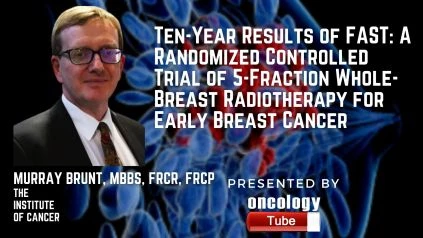Murray Brunt, MBBS, FRCR, FRCP The Institute of Cancer discusses an article in The Journal of Clinical Oncology entitled Ten-Year Results of FAST: A Randomized Controlled Trial of 5-Fraction Whole-Breast Radiotherapy for Early Breast Cancer
Intent —
Earlier studies of hypofractionated whole-breast adjuvant radiotherapy for early breast cancer developed a standard 15- or 16-fraction (fr) protocol. Normal tissue effects (NTE) and disease outcomes after 5-fr regimens were evaluated in the Quick Trial (CRUKE/04/015). Ten-year outcomes are given.
METHODS
Women aged 50 years with low-risk invasive breast carcinoma (pT1-2 pN0) were randomly assigned to either 50 Gy/25 fr (5 weeks) or 30 or 28.5 Gy in 5 once-weekly fr of 6.0 or 5.7 Gy. The primary endpoint was an improvement in photographic breast appearance at 2 and 5 years; secondary endpoints were NTE and local tumor control evaluations by the physicians. Odds ratios (ORs) compared regimens from longitudinal analyses.
RESULTS
A total of 915 women were recruited from 18 centers in the UK (2004-2007). Five-year images of qualifying patients were available for 615/862 (71 per cent). For 30 Gy and 1.10 (95 percent CI, 0.70 to 1.71; P = .686) for 28.5 Gy versus 50 Gy, the ORs for improvement in photographic breast appearance is 1.64 (95 percent CI, 1.08 to 2.49; P = .019). The alpha / β photographic endpoint estimate was 2.7 Gy (95 percent CI, 1.5 to 3.9 Gy), giving an average iso-effective 5-fr schedule of 28 Gy (95 percent CI, 26 to 30 Gy) with 50 Gy/25 fr. ORs were 2.12 (95 percent CI, 1.55 to 2.89; P < .001) for 30 Gy and 1.22 (95 percent CI, 0.87 to 1.72; P = .248) for 28.5 Gy versus 50 Gy for any moderate / marked doctor-assessed breast NTE (shrinkage, induration, telangiectasia, edema). With a median follow-up of 9.9 years, 11 ipsilateral breast cancer incidents have occurred (50 Gy:3; 30 Gy:4; 28.5 Gy:4) and 96 deaths (50 Gy:30; 30 Gy:33; 28.5 Gy:33)).
FINDINGSÂ
There was no major difference in NTE values at 10 years after 28.5 Gy/5 fr compared to 50 Gy/25 fr, but NTE after 30 Gy/5 fr was higher. Results support the reported 3-year findings that it is possible to define a once-weekly 5-fr whole-breast radiotherapy schedule that appears to be radiobiologically equivalent to a conventionally fractionated protocol for NTE.

